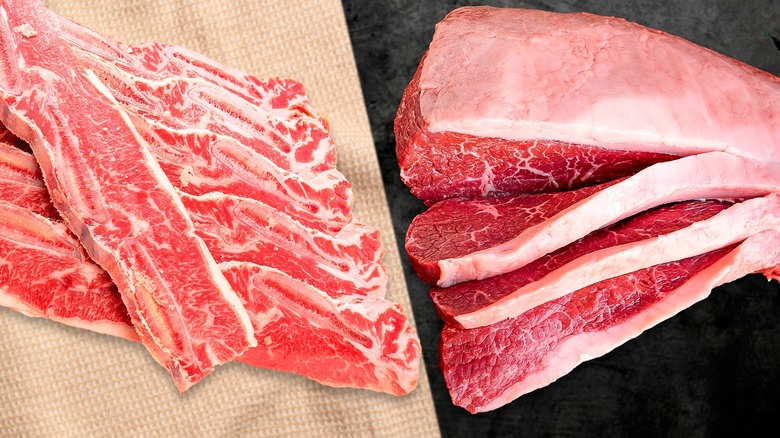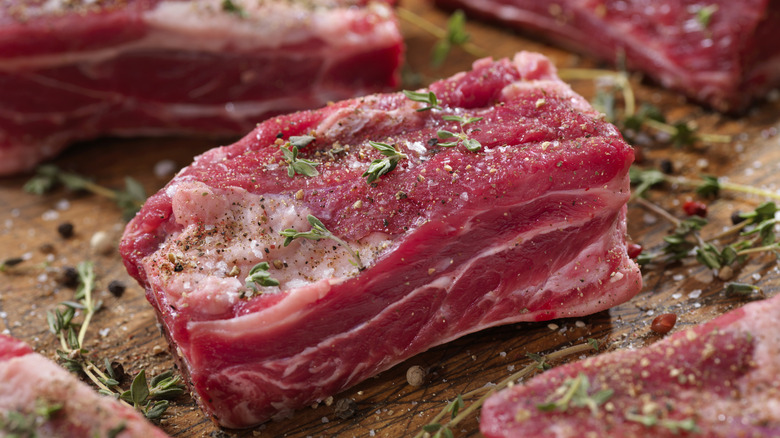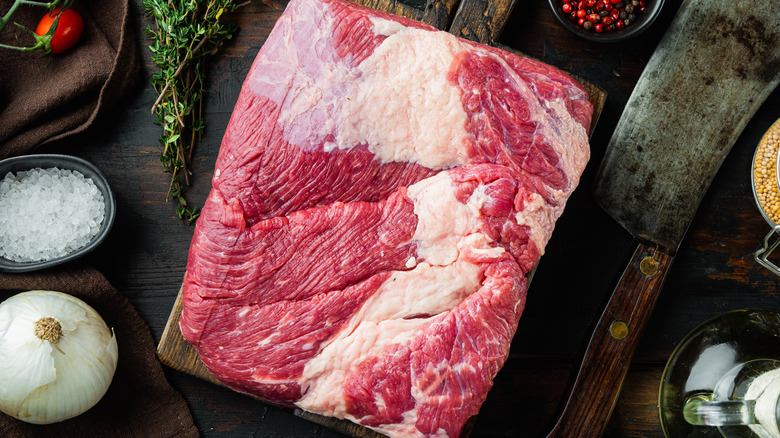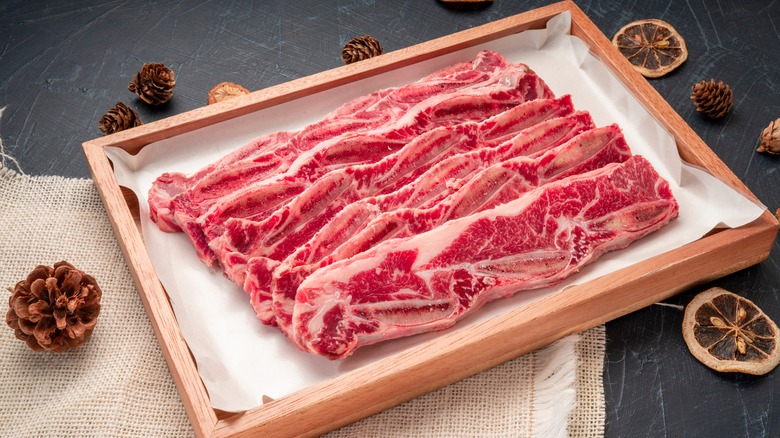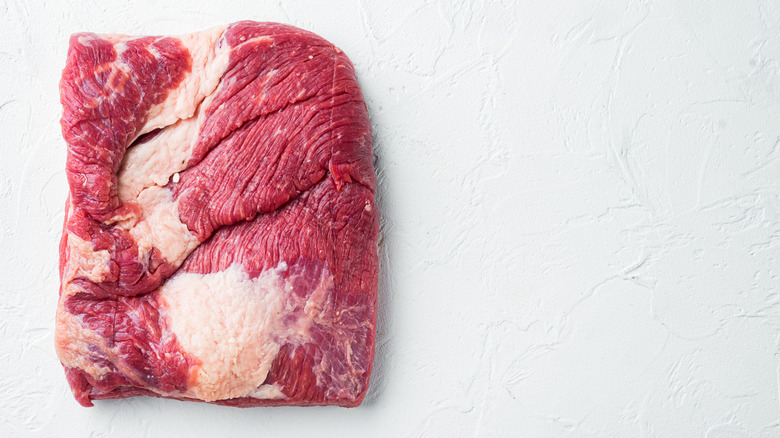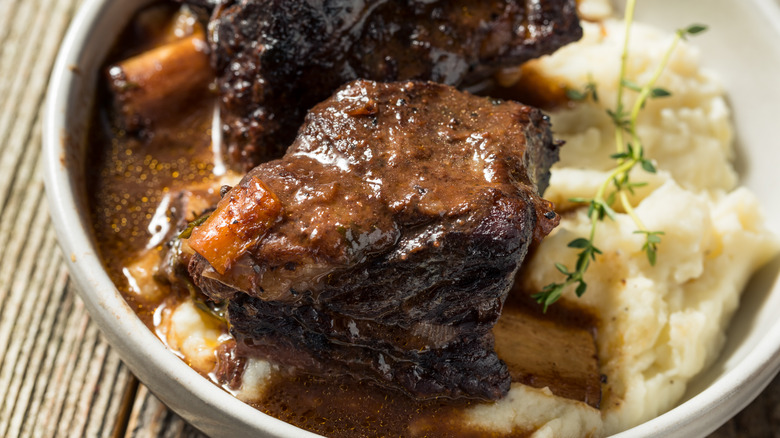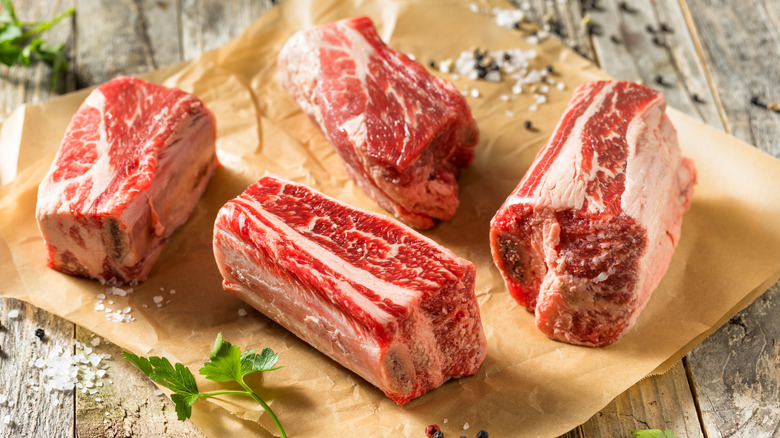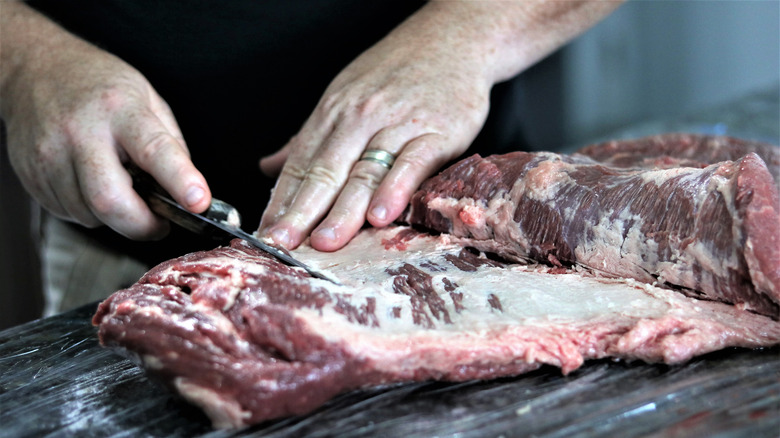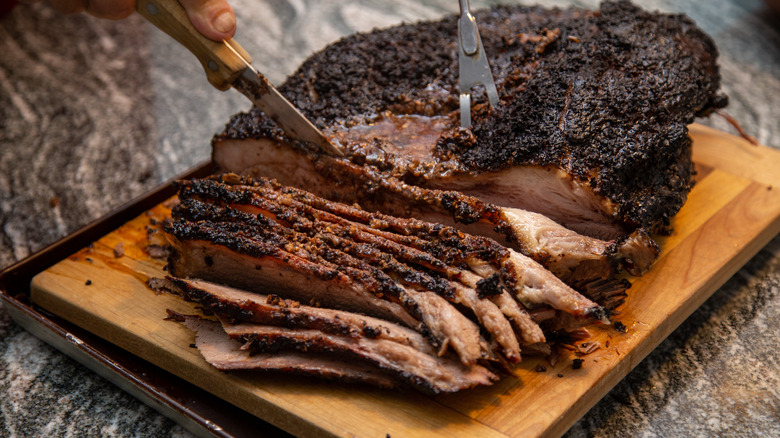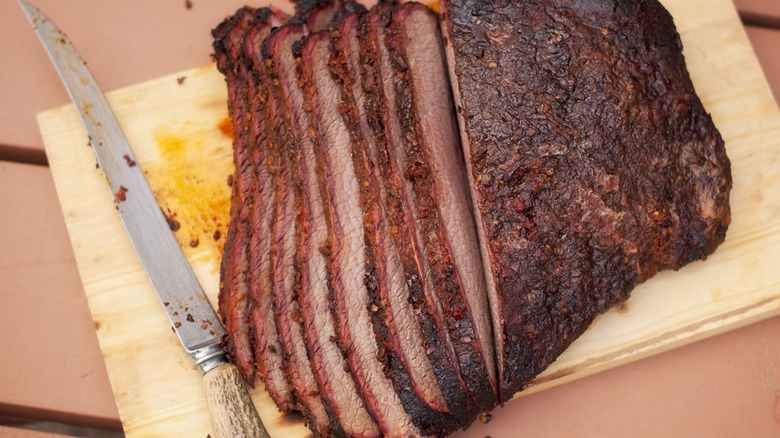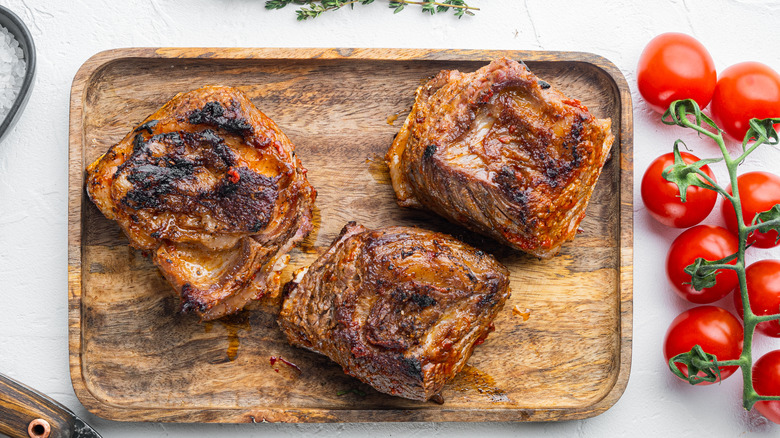Short Ribs Vs Brisket: Everything You Need To Know
It used to be that the most sought-after cuts of beef were the ones that were easily prepared as steaks: things like ribeyes or New York strips or tenderloins. But these days, the cuts long perceived as lesser are far more sought out than they once were, cuts like oxtail, skirt steak, short ribs, or brisket. The latter was once so poorly perceived it was given away for free!
If these cuts were long maligned, it's not because there's anything inherently wrong with them. In fact, it's quite the opposite: Cuts hailing from muscles that do a lot of work tend to develop a lot more collagen, rendering them quite chewy at first. But with a bit of TLC, that collagen can be coaxed out, making these cuts flavorful, juicy, and oh-so-tender. Both short ribs and brisket fall into this category, meaning that they require a bit more work than a tenderloin to rise to their full potential. When cooked too quickly, both brisket and short ribs can be chewy and even stringy. But when slow-cooked as in a braise or a smoker, they reveal themselves to be total flavor bombs.
Of course, brisket and short ribs aren't interchangeable. To get to the bottom of what makes them stand out from one another — and, for that matter, from other cuts of beef — we tapped a few experts, who shared tips, tricks, and secrets to help you reach slow-cooked beef mastery.
Short ribs can come from different parts of the cow
Short ribs should be fairly self-explanatory: They come from the ribs of the cow, right? Unfortunately, it's not quite so simple, according to Chef Jeff McInnis, Chef/Owner of Mi'Talia Kitchen & Bar, Stiltsville Fish Bar, and Root & Bone, who says, "This gets complicated." In reality, there are four different sections of the cow from which short ribs may come: the chuck, the brisket, the plate, or the rib. And they're not all created alike.
"Usually, chuck short ribs are meatier but can be tougher," explains Chef Lenny DiMaria from Patricia's of Holmdel. "Whereas short ribs from the rib do not have as much meat but are more tender."
Short ribs cut from the plate, he adds, tend to be fattier. And they pale in comparison to chuck, which has the best marbling and comes from the thickest muscle. It's rare you'll find it in restaurants, however, according to Chef Kenny Gilbert, VP of Culinary Operations at Grove Bay Hospitality Group. He claims that many restaurants instead opt for the chuck flap, which comes from the shoulder of the cow and is less expensive than the true chuck short ribs.
Brisket always comes from the breast of the cow
As opposed to short ribs, brisket always comes from the same spot: the lower chest of the cow, also known as the breast. Because these muscles get a lot of work, they have a lot of connective tissue. The resulting cut is super flavorful but can tend to be tough; it's only with low, slow cooking that the collagen in brisket can be melted, translating to perfect tenderness.
While brisket isn't quite as complicated to get a handle on as short ribs, it is nevertheless composed of two cuts. The point, also called the deckle, is fattier than the flat, which also known as the first cut. An untrimmed or packer brisket will have both pieces together, aka the best of both worlds, though given their differences in size and fat content, some cooks prefer to opt for just one or the other.
Short ribs can be butchered and sold multiple ways
Even once you've zeroed in on the actual cut of short ribs you want to use, you may still have some decisions to make. Short ribs can be sold butchered in one of two ways: flanken or English. (The former may also be known as crosscut ribs, kosher ribs, or Korean-style ribs, while the latter may also be dubbed braising ribs, barbecue ribs, or fancy-cut ribs.
Flanken-cut short ribs have a thinner strip of meat running across several bones, making them perfect for use in traditional Korean short ribs recipes like galbi. English-style ribs, meanwhile, have a thicker piece of meat on the bone, making them ideal for braising low and slow in a red wine gravy. You can ask your butcher to divest some or most of the fat from English-style ribs, depending on how you plan to use them, and they may also be available as riblets, which, as their name suggests, are smaller and more manageable than the four to five-rib cut that's more typical in the butcher case.
Short ribs have more even fat distribution than brisket
Both short ribs and brisket get much of their flavor from fat, but the fat isn't as evenly distributed on the latter as on the former. Whereas brisket has a large, leaner section covered by a cap of fat, according to Corporate Executive Chef Patrick Rebholz of 50 Eggs Hospitality, the force behind the culinary program at Yardbird. The fat distribution on short ribs, according to DiMaria, is far more uniform.
"When looking at brisket, there is a noticeable contrast between a distinct fatty side and lean side," he explains. "Whereas in short ribs, there is an even distribution of fat seamlessly interwoven throughout the meat." This uneven fat distribution contributes to some of the difficulty of cooking brisket properly, and it can also give it the false reputation of being an overly fatty cut. Depending on the way you're using it, trimming brisket can make it a whole lot leaner — and given the presence of marbling in short ribs, a trimmed brisket may even prove the leaner of the two.
Short ribs are more expensive than brisket
When asked which was more expensive, short ribs or brisket, our chefs were unanimous in pointing to the former. "When comparing apples to apples (same grade of beef to same grade of beef)," McInnis says, short rib is definitely pricier. "But you never know as the meat industry is a roller coaster, especially around the holidays," he adds.
While prices can change and vary according to the season and availability, brisket generally costs an average of $4 to $5 dollars a pound, while raw beef ribs can cost anywhere from $3.25 per pound less to more than $5.30 per pound.
"They are by far my lowest margin item on the menu," Justin Fourton of Pecan Lodge tells Texas Monthly. It's no wonder so many restaurants opt for slightly lesser short ribs, like those cut from the chuck flap rather than the chuck, to make ends meet.
Short ribs are less stringy than brisket
Both brisket and short ribs benefit incredibly from a low, slow braise or smoke. But while given this treatment, short ribs melt into fork-tender morsels, even slow-cooked brisket never really loses all of its stringiness. "Briskets are a tough cut of meat, but can become tender when slow cooked or smoked, making [them] melt in your mouth," explains DiMaria. "Short ribs are tender and succulent, and tend to deliciously fall apart."
It's perhaps no wonder that back in 2012, Melissa Clark wrote in the New York Times that her family had flouted tradition and "banished brisket from our Seder," opting instead for boneless short ribs for a "plusher and much less stringy" result.
That said, McInnis notes that brisket certainly has its place. "Short ribs are a bit softer, fattier, but brisket has its perks," he says. "When slow smoked properly, nothing is better."
Short rib has a bone in it ... usually
As the name suggests, short rib usually comes with a bone — a rib bone, to be precise. But boneless short ribs are definitely a thing, and for McInnis, it's this boneless cut that holds the most interest. "The common bone-in short rib that you see in restaurants is super cool and a crowd pleaser," he says, "but as chef[s], we pay a lot of money for this cut and then serve it with a big heavy bone in it."
He can't negate, of course, how delicious it is to cook meats on the bone. While the idea that cooking meat bone-in lends more flavor is more of the order of myth, bones do help heat to transfer more slowly, rendering the resulting meat even juicier and more tender. But despite this — and the impressive presentation of serving a whole, bone-in short rib — for McInnis, the cost doesn't always make it worthwhile.
"The boneless chuck flap is one of my secret weapons," he says. "It's delicious and has so many uses. It tastes just as good as the bone-in version but without paying for the bone."
Both short rib and brisket usually require trimming
Both brisket and short rib fare better with a bit of trimming, but not of the exact same detritus. Since the brisket has a fatty side, depending on how you're using it, you may need to trim some or all of the excess fat, explains Rebholz. "I would suggest trimming a consistent fat cap so rendering yields a distribution of fat/moisture throughout the brisket," he says.
But depending on your recipe, you may wish to leave some or all of the fat attached. "Most of the time for the applications I do, trimming is not necessary," says McInnis.
When working with short rib, it's not necessary to trim off any excess fat — at least not before cooking it, according to McInnis. "For short rib, I suggest trimming after braising and cooling in braising liquid," he says. "This is because the larger segments of fat are within the muscle and can be extracted more efficiently after the meat is cooked and cooled, or while portioning."
But whether you're working with brisket or short ribs, before you get cooking, you'll want to be sure to trim the silver skin, a translucent membrane of connective tissue that turns chewy when cooked.
Of course, if any of this is making you squeamish, you don't need to do all this trimming on your own. DiMaria notes that many butchers will do this work for you; all you need to do is ask.
Brisket is harder to cook evenly than short rib
If you've ever heeded a TV chef's advice to keep all of your pieces of meat or veg the same size so that they cook through evenly, you'll understand why brisket can be tough to get just right. Since brisket is thicker in some parts and thinner in others, and given the presence of a fat cap covering just one side, it should come as no surprise that it's a bit trickier to perfect.
"Briskets have a lean flat section and a larger cross section that make it difficult to cook consistently throughout without losing fat/moisture content," explains Rebholz, and this in contrast to short ribs, which, given their evenness in both thickness and fat distribution, means that they "yield a more consistent product when cooked," according to the chef.
To successfully cook a brisket through evenly, some chefs prefer to divide the brisket in two, pulling the leaner flat off when it's cooked through and leaving the point to finish on its own.
Brisket is leaner and higher in key vitamins and minerals than short rib
Both brisket and short rib are high in essential nutrients like protein, iron, zinc, selenium, potassium, and B vitamins. But brisket does have a few advantages over short rib in the nutritional department. In spite of the presence of its consequential fat cap, trimmed brisket is actually leaner than short rib given the uneven fat distribution in this cut. "Short ribs are consistently marbled throughout the entirety of the muscle," says Rebholz, "so if I had to choose between the two, I would choose brisket as leaner."
Brisket is also richer in certain nutrients such as zinc, selenium, Vitamin B3, Vitamin B5, and choline. Short ribs do have a few points on their side, however: They are richer in vitamin B12 and healthy monounsaturated and polyunsaturated fats, and comparatively lower in saturated fat; brisket has 52% more saturated fat than short ribs, which can lead to high cholesterol levels and even heart disease or stroke.
Both short ribs and brisket are best cooked low and slow
Both brisket and short ribs benefit from long cooking times over relatively low heat — something that can inspire no shortage of distinct, delicious recipes. "I love smoking both," says Gilbert. "But I prefer braising short ribs and also grilling, kalbi style."
Rebholz echoes a love of this Korean-style short rib preparation, but that's just the tip of the iceberg when it comes to ways he loves enjoying this cut of beef. "Braised and stuffed into a ravioli, or sliced into a grilled cheese sandwich and smoked — always a good move," he says. DiMaria adds his favorite: slow-cooking them and serving them over mushroom risotto.
When it comes to brisket, Rebholz is "a sucker for a true Texas-style BBQ, a fine art that many can pull off!" (Try your hand at it with this smoked brisket recipe.) You may also consider braising brisket, as in a pot roast, or curing it to make smoked meat or pastrami.
At the end of the day, according to DiMaria, many cooking methods that would work well for one would also work for the other, as long as you remember not to rush. "I prefer to cook brisket and short rib low and slow because the meat becomes deliciously tender," he says.
